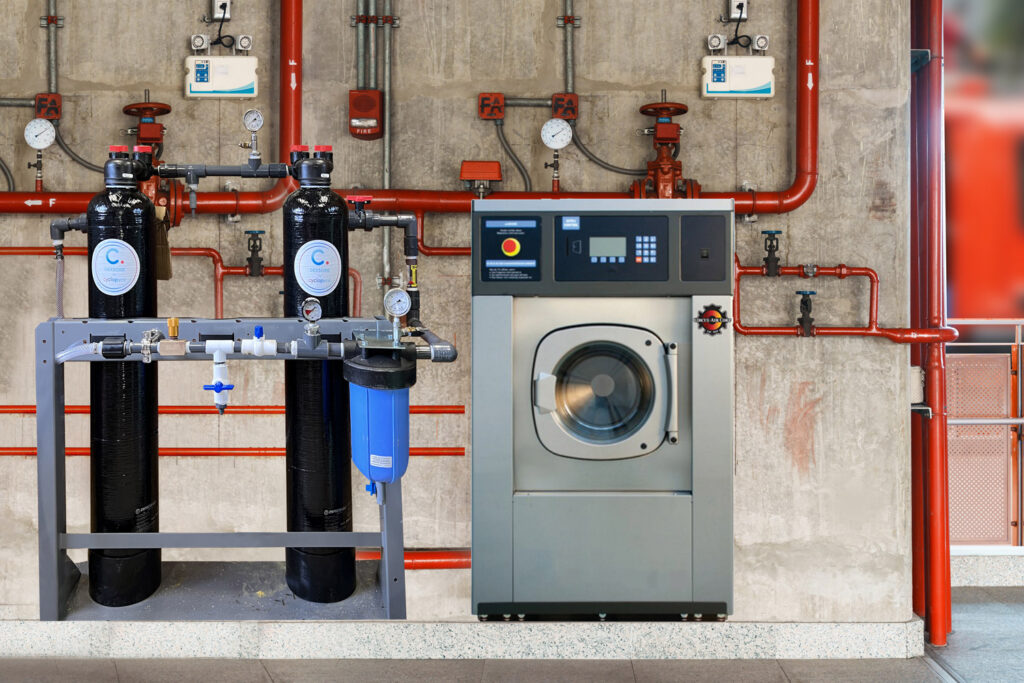Fire Department Wastewater Filtration Solutions
Protect Your Station and Community
Fire stations handle high-risk contaminants daily, especially from firefighting gear. Proper wastewater filtration from washer-extractors is crucial for safeguarding your team and the environment. Our innovative DEXSORB® system offers a cutting-edge solution to treat PFAS and other harmful contaminants, ensuring safe disposal and compliance with environmental standards.

Why Choose DEXSORB®?
1 PFAS Removal Excellence:
DEXSORB® features uniform 0.78-nm hydrophobic cavities designed to target and remove PFAS (per- and polyfluoroalkyl substances) from wastewater. Its molecular selectivity ensures the highest performance, even in the most challenging water systems.
2 Tailored for Fire Stations:
Designed to handle the unique challenges of fire station wastewater, including oils, grease, and natural organic matter. Our filtration system works seamlessly with washer extractors to ensure contaminants from firefighting gear do not re-enter the environment.
3 Cost-Effective and Sustainable:
- Low operational costs with long media life and reduced frequency of changeouts.
- Regenerable media for multiple cycles, minimizing waste and disposal costs.
- Compact design requiring minimal footprint, perfect for fire station setups.
4 Total Solution for PFAS Management:
Our DEXSORB® system is more than just filtration. It provides a comprehensive service that includes efficient PFAS filtration, safe disposal, and incineration to ensure complete elimination of contaminants. Fire stations can trust our worry-free service delivery to handle every step of the process, safeguarding both their team and the environment.
How Incineration Ensures Safety:
Incineration is a critical step in the disposal of PFAS, as it completely breaks down these persistent chemicals at high temperatures, typically exceeding 1,000°C. This process ensures that PFAS compounds are destroyed at a molecular level, preventing their release back into the environment. By utilizing advanced incineration methods, we eliminate the risk of secondary contamination, offering a safe and environmentally responsible solution for PFAS waste management.
Key Features:
- Single-Step Filtration Process: Effortlessly filters contaminants with smooth operating hydraulics and low-pressure drop. Compatible with pressurized vessels and gravity filtration tanks.
- Certified Safety: NSF/ANSI 61 certified for safe water treatment.
- No Matrix Impacts: Effectively manages total dissolved solids (TDS), total organic carbon (TOC), fats, oils, and grease (FOG).
- Scalability: Designed for low to high flow rates, making it adaptable to the varying demands of fire station operations.

DEXSORB® FAQ
What is Dexsorb?
DEXSORB is a plant-based adsorbent made with beta-cyclodextrins, available in powder or granule form. It was developed to remove PFAS and other organic micropollutants from water supplies. The media utilizes molecular selectivity to target PFAS with rapid, high-capacity adsorption.
WHAT IS THE ADSORPTION MECHANISM OF DEXSORB FOR PFAS?
DEXSORB removes PFAS from contaminated water through the hydrophobic interaction between PFAS and cyclodextrin cavities. The uniform 0.78 nm cavities provide molecule-level selectivity for PFAS and organic micropollutants. This provides short empty bed contact time (EBCT), small infrastructure, and low media volume.
WHAT IS THE LIFE CYCLE OF DEXSORB?
DEXSORB offers a sustainable solution, as the media can be regenerated for several cycles of reuse. Regeneration is accomplished in a solution-based desorption process performed under ambient conditions to separate PFAS waste and fully restore DEXSORB media capacity.
BESIDES PFAS, DOES DEXSORB REMOVAL OTHER CONTAMINANTS?
DEXSORB is effective for the treatment of other organic micropollutants in the 150 to 1000 Dalton range including pesticides, pharmaceuticals, and industrial chemicals. DEXSORB does not remove inorganic ions (e.g., metals, chloride, sulfate, fluoride, etc.).
HOW STABLE IS DEXSORB IN WATER TREATMENT APPLICATIONS?
DEXSORB has superior biological and physicochemical stability. It can be applied in challenging environments and is not affected by aerobic or anaerobic biological activities, residual disinfectants such as free chlorine, varying pH, and hardness.
HOW IS THE DEXSORB WASTE HANDLED?
A beneficial output of regeneration is that extracted PFAS are isolated and further processed into a concentrated waste stream for efficient handling and disposal by existing destruction technologies. This avoids disposal complications encountered by single-use media and prevents captured PFAS from re-contaminating the environment.
Are there any issues with transporting spent DEXSORB across state or country borders? Are there any special shipment requirements?
The spent DEXSORB media is not classified as hazardous waste, so there are no special shipping requirements. For small-scale systems (such as those designed fire stations), we provide pre-paid shipping labels, vessel caps, and boxes for returning the used media vessel for proper waste handling and incineration. For full-scale systems, we handle the shipment of spent media to our regeneration facility, which is fully permitted for hazardous waste handling. We have extensive experience shipping media across the continental U.S. and internationally.
How does DEXSORB address changes in local, state, or federal wastewater PFAS regulations?
DEXSORB is highly effective at removing PFAS to non-detectable levels (< 2 ppt), which exceeds even the most stringent PFAS regulations, such as the EPA’s drinking water maximum contaminant level (MCL) for PFOS/PFOA of 4 ppt. DEXSORB is also capable of removing a wide range of PFAS compounds, including those not yet regulated. Our analytical team consistently monitors DEXSORB’s performance in removing over 80 PFAS compounds from various water sources.
How does the system handle other contaminants, such as heavy metals, oils, and VOCs? Do the filters lose effectiveness depending on the types of byproducts that pass through?
DEXSORB is uniquely designed to remove PFAS even in the presence of other contaminants like heavy metals, oils, and VOCs. Its selectivity for PFAS and resistance to fouling from other water constituents make it highly effective in complex water matrices, such as landfill leachate and industrial wastewater. The only pretreatment required is managing suspended solids. While DEXSORB may also remove other small organic contaminants (150–1000 Da), this does not affect the predicted lifespan of the vessels.
